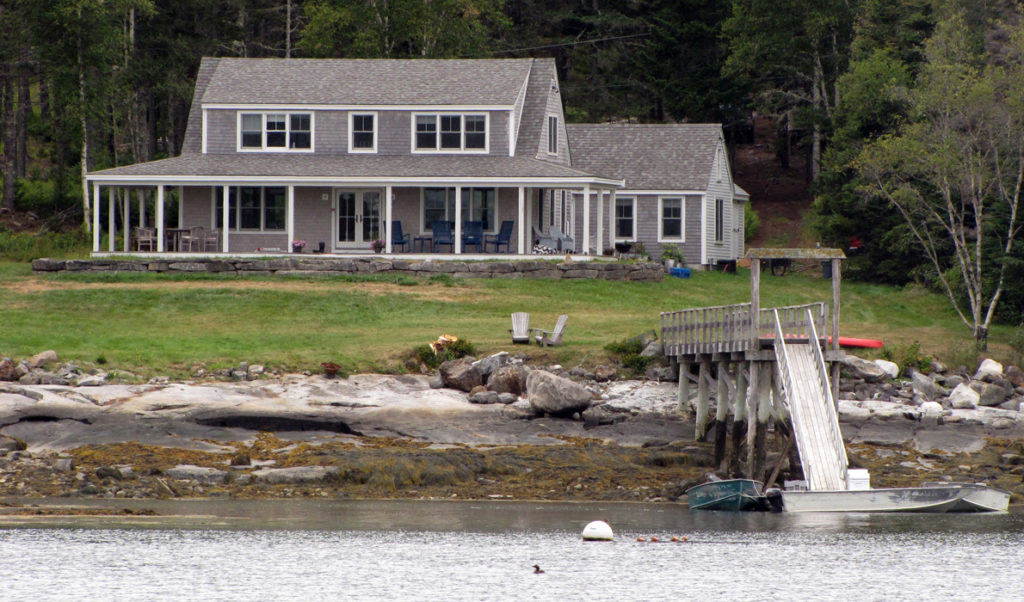By Jacqueline Weaver
Smaller homes, single floor living, separate guest houses for visiting children, and walls of windows that open to the outdoors are all current trends in building and renovation projects along the Maine coast, according to a number of contractors and banks.
Danielle Betts, director of design and business development for the Knickerbocker Group Inc. in Portland and Boothbay, said the architectural, interior design, woodworking, and construction firm is seeing clients opting for smaller homes.
“The homes are designed to meet the daily needs of two, year-round occupants on one floor,” said Betts. “Additional bedrooms for adult children and guests are designed on a second floor, lower level, or in a detached bunkhouse or carriage house on the same property.”
She said that although Knickerbocker’s clients remain drawn to the classic Maine cottage design, they want more and larger windows with movable wall systems that open the indoors directly to a screen porch or outdoor terrace.
Customers of Whitecap Builders in Belfast often ask for estimates on a new home and then decide instead on a major renovation of an existing property, said the owner, Daniel Waldron. He and his business partner and wife, Kathleen Dunckel, find everyone wants to maximize their views with improved windows.
Also in demand are first floor bedroom suites, heat pumps for energy efficiency, and positioning new homes on the land to maximize energy efficiency savings with items such as solar panels.
“The additions can range from $30,000 to $300,000 with the high end including the addition of living space or a master suite and a total renovation of the interior space,” Waldron said. Clients tend to want smaller homes, he added, and for this reason Whitecap Builders is working on a design for a home it will later market of 1,300-to-1,700 square feet. Waldron said the square footage costs range from $200 to $250 depending on what finishes the buyer wants.
Pam Kenniston, a senior vice president and senior retail loan officer with Camden National Bank based in the Midcoast, said that although she recently financed a $1 million home on the ocean, most construction loans these days fall in the range of $250,000 to $350,000. Most home designs are one story with a detached garage, at times with a bonus room above for a future in-law apartment and/or a full walkout basement to add to the living space.
In terms of trends, “going green” with a carbonless footprint is popular, she said. But Kenniston said energy efficiency measures such as added wall insulation that require thicker walls add a significant cost to the home.
“Yes, it helps offset future heating and electricity bills, but the upfront costs do not add value to the home since all homes require heat, electricity, etc.,” she said. “Many have to scrape the idea of an energy efficient home so it is affordable, or they have to scale back the project substantially to make their budget and the appraisal work.”
Smaller homes, she said, are the trend.
“The days of the larger homes have definitely passed,” Kenniston said. “It is more about convenience, cost and looking down the road knowing as they themselves age, they do not want a two story home to clean and no stairs to climb.”
Audrey Eaton, a mortgage originator for Bar Harbor Bank & Trust, works with clients from Winter Harbor and Blue Hill in Hancock County to the Midcoast towns of Rockland and Topsham. The second home market continues to be strong and waterfront properties are always popular with these buyers, she observed, although more buyers are seeking construction loans due to a shortage of waterfront real estate inventory.
These second home buyers, she said, want space for multi-generational family as well as for other guests and are attracted to homes with several ensuite bedrooms or a family compound with a large house and a few guest cottages.
Bob Coombs II, president of RL Coombs Inc., in Topsham, said his customers are gravitating toward more modern styles both in remodeling and in new construction. Like other builders, he finds clients want single floor living with multi-use rooms, open concept layouts and maintenance free products.
“They don’t want to be stuck maintaining the homes in our harsh Maine weather along the coast,” Coombs said. Rising construction costs and additional building code requirements make a custom-built home less attainable for middle income families.
“Most of the homes we are building are higher end, luxury homes that are used primarily as second or seasonal homes,” Coombs said.
W. Dean Bowers, executive partner of Hancock Homes in Hancock, said he, too finds the homes his clients are requesting are smaller, single story and with guest accommodations.
“Customers wants less to take care of, yet we see more demand for better quality maintenance free materials and high-end amenities,” Bowers said. He said construction costs tend to run about $300 per square foot and can very easily increase from that figure as customers choose more high-end options. Rising material and equipment costs are driving prices up, Bowers said, as are labor costs.
“Most of our experienced carpenters come to work with a heavy duty ¾-ton truck and work trailer fully equipped with tools, the cost of which is now approximately $100,000 for the experienced craftsman, not to mention the cost of staging, safety and other major equipment usually provided by the employer,” he said. “You can no longer interest young people into the trades for much less than $19 per hour or it’s not worth their effort to invest in the tools and equipment.”





